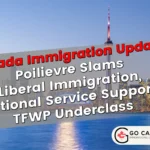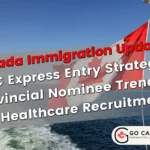August 2025 Canada updates: 214,520 fewer arrivals align with sustainable goals, Yukon boosts YNP to 282 slots, Start-Up Visa faces 52-month delays, Francophone target hits 12% by 2029, and refugee claims soar to 11,163 in July. Go Canada Services offers expert support.
Canada August 2025 Immigration Updates: Fewer Arrivals, Yukon Nominee Expansion, Start-Up Visa Delays, Francophone Goals, and Refugee Surge
214,520 Fewer Arrivals, Yukon Nominee Boost Introduction
August 2025 highlights significant shifts in Canada’s immigration landscape, reflecting efforts to balance economic needs, integration, and humanitarian commitments. The 2025–2027 Immigration Levels Plan yields 214,520 fewer arrivals,
The Yukon Nominee Program (YNP) expands to 282 slots, the Start-Up Visa (SUV) program faces 52-month delays and high refusals, Francophone immigration targets rise to 12% by 2029, and refugee claims hit a record 11,163 in July.
These align with broader debates on deportation policies, labour programs, and integration, as covered in prior user queries. Go Canada Services, a trusted immigration firm since 2004, offers expert guidance. This article addresses the user’s Arabic query on these updates, integrating web and X sources for context.
214,520 Fewer Arrivals: Progress Toward Sustainable Goals
Canada’s immigration reforms are reducing arrivals to address infrastructure pressures. Key details:
- Details: From January to June 2025, Canada saw 214,520 fewer international students and temporary workers compared to 2024, driven by a 10% study permit cap reduction (305,900 in 2025) and tighter work permit eligibility (e.g., LMIA requirements). The 2025–2027 plan targets 673,650 temporary residents in 2025, aiming to reduce non-permanent residents to below 5% of the population by 2026. This eases housing (3.9 million homes needed by 2031) and service strains (15% doctor shortage).
- Context: The plan balances economic needs (54% of 395,000 PRs in 2025 for economic streams) with public concerns (58% of Canadians say immigration is too high, per Environics). X posts from @FPVaughanIII advocate stabilizing population at 200–250,000 annually.
- Impact: International students and workers should secure permits early, focusing on high-demand sectors (e.g., healthcare, trades) to navigate stricter rules. Housing affordability may improve, with a projected 670,000-unit gap reduction by 2027.
For study or work permit support, contact Go Canada Services’ Free Assessment.
Yukon Nominee Program Boosts Opportunities
The Yukon expands its immigration pathways with increased YNP allocations. Key points:
- Details: Yukon secured 67 additional YNP slots, raising the 2025 total to 282 (from 215). This allows 80 new employer invitations from the Expression of Interest pool, prioritizing long-term residents, university graduates, French speakers, and those with Yukon government support letters. Ten slots are reserved for regulated healthcare roles until September 30, 2025, then redistributed.
- Context: Yukon’s labour market (5.8% unemployment, July 2025) relies on immigrants for healthcare and tourism. The YNP aligns with Canada’s regional focus, complementing programs like the Atlantic Immigration Program (5,000 PRs annually). X posts from @YukonGov highlight advocacy success.
- Impact: Eligible candidates should submit EOIs early, emphasizing Yukon ties or French proficiency (NCLC 7+). Employers must align with healthcare priorities to access reserved slots before redistribution.
For YNP application support, explore Go Canada Services’ Permanent Residency Services.
Start-Up Visa Program Faces Record Delays and Refusals
The SUV program struggles with inefficiencies, deterring entrepreneurs. Key findings:
- Details: Processing times reached 52 months in Q1 2025, with refusal rates at 73–85% (77% for work permits). Annual spots drop from 5,000 to 1,000 by 2027, reflecting IRCC’s focus on economic streamlining. Stakeholders urge reforms, like investor programs or point-based systems, as competitors (e.g., UK, UAE) attract talent. Common refusal reasons include weak business plans and insufficient innovation proof.
- Context: The SUV targets tech entrepreneurs but competes with Express Entry (18,500 French-language ITAs in 2025). X posts from @CanadimLaw warn of losing talent to global hubs.
- Impact: Applicants must submit robust business plans (e.g., $100,000+ investment, market analysis) and consider PNP entrepreneur streams (e.g., Ontario). Work permits remain a viable interim option despite refusals.
For SUV or business immigration support, visit Go Canada Services’ Business Immigration Services.
Francophone Immigration Target Rises to 12% by 2029
Canada prioritizes French-speaking immigrants despite overall cuts. Key insights:
- Details: Prime Minister Mark Carney set a 12% Francophone PR target outside Quebec by 2029 (up from 8.5% in 2025), addressing the decline from 6.1% (1971) to 3.5% (2021). Supported by Express Entry draws (18,500 ITAs in 2025, CRS as low as 379) and pilots like the Francophone Community Immigration Pilot, this counters broader PR reductions (395,000 in 2025).
- Context: The Official Languages Act and FCFA advocacy drive this focus. Francophone streams in New Brunswick and Manitoba enhance access. X posts from @FCFA_Canada praise lower CRS thresholds.
- Impact: French-speaking applicants (NCLC 7+) should target Express Entry or PNP Francophone streams, leveraging +50 CRS points for bilingualism. Rural communities may see economic boosts.
For Francophone immigration support, contact Go Canada Services’ Contact Page.
Refugee Claims Surge to Record Levels in July 2025
Canada’s refugee system faces unprecedented pressure. Key findings:
- Details: July 2025 saw 11,163 new refugee claims (36.7% increase from June), with a backlog of 291,975. Refugee appeals hit 1,080, and immigration appeals reached 531. Global conflicts (e.g., Sudan, Ukraine) and climate displacement drive this, straining IRCC’s capacity (80% of applications within service standards).
- Context: The 2025–2027 plan allocates 59,250 PR spots for refugees, but processing delays (6–12 months) persist. American claims (245 in H1 2025) reflect U.S. policy shifts. X posts from @Betar_USA note transgender claimants.
- Impact: Claimants should provide robust persecution evidence (e.g., legal documents) and seek legal aid to navigate backlogs. IRCC’s $1.1 billion funding may expedite processing by 2026.
For refugee claim support, explore Go Canada Services’ Free Assessment.
Broader Context from Prior Queries
- Poilievre’s Deportation Policy: Targets non-citizen criminals for immediate deportation, with increased CBSA funding, aligning with a 250,000 cap.
- TFWP Underclass: 140,000 workers risk social exclusion; PR pathways needed.
- National Service: 70% support for integration via civilian service.
- Bill C-3 Concerns: Open-ended 1,095-day citizenship rule risks fraud.
- PGP Contradictions: Values grandparents but limits PR amid cuts (90,000 by 2027).
- American Refugee Claims: 245 claims in H1 2025, driven by transgender issues.
Other Key Updates
- Alberta AAIP Draws: 683 invitations (August 7–12): 63 Healthcare Express Entry (CRS 56), 39 Healthcare Non-Express Entry (score 53), 581 Opportunity Stream (score 70).
- Biometrics for Citizenship: Mandatory fingerprints and facial recognition start 2026–2027 ($85–$170).
- Afghan Refugee Crisis: 3,000 Afghans in Tajikistan face deportation; IRCC works with UNHCR.
- Immigrant Unemployment: 11.2% for recent immigrants vs. 6.2% for Canadian-born (July 2025).
- Canadians in ICE Detention: 150 detained since January 2025, 56 still in custody.
- Undocumented Residents: Economists urge including 500,000 in planning.
- Express Entry Medical Exams: Mandatory upfront exams start August 21, 2025 ($140–$280).
- Newfoundland Draws: 231 invitations on August 13 (180 NLPNP, 51 AIP).
- Data Transparency: Carney administration withholds data since May 2025.
- Refusal Rates: Study permits (65.4%) and visitor visas (50%) face high refusals.
Immigration and Settlement Strategies
- International Students/Workers: Apply early for permits, targeting high-demand sectors (healthcare, trades) to counter caps and refusals.
- YNP Applicants: Submit EOIs with Yukon ties or French proficiency; healthcare workers should apply before September 30, 2025.
- SUV Applicants: Prepare robust business plans ($100,000+ investment) and explore PNP entrepreneur streams.
- Francophone Applicants: Leverage Express Entry (NCLC 7+, +50 CRS points) or Francophone PNP streams for PR.
- Refugee Claimants: Provide strong persecution evidence; engage legal aid to navigate backlogs.
For tailored strategies, start with Go Canada Services’ Free Assessment.
Frequently Asked Questions
- Why are there 214,520 fewer arrivals in 2025?
A 10% study permit cap reduction and tighter work permit rules reduced arrivals, aligning with the 2025–2027 plan’s goal of under 5% non-permanent residents. - What is the Yukon Nominee Program expansion for 2025?
Yukon secured 282 YNP slots (67 new), prioritizing long-term residents, graduates, French speakers, and healthcare workers. - Why is the Start-Up Visa program delayed?
Processing times hit 52 months with 73–85% refusals due to weak business plans; spots drop to 1,000 by 2027. - What is the Francophone immigration target?
Canada aims for 12% Francophone PRs outside Quebec by 2029, supported by Express Entry and pilot programs. - Why did refugee claims surge in July 2025?
July saw 11,163 claims (36.7% increase) due to global conflicts and climate displacement, with a 291,975-case backlog.
Why Choose Go Canada Services?
Go Canada Services excels in navigating Canada’s immigration pathways, offering solutions for Permanent Residency, Work Permits, Study Permits, and Family Sponsorship. Their regulated consultants ensure compliance with IRCC and provincial requirements. Start with a Free Assessment or contact them at Go Canada Services’ Contact Page.
Call to Action
Begin your journey to Canada with Go Canada Services. Schedule a consultation for immigration, work, or settlement support. Satisfied with their services? Leave a review on Google.



